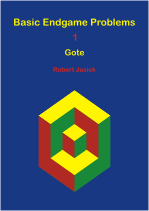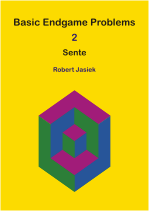Basic Endgame
Problems 1 - Gote,
Basic Endgame Problems 2 - Sente
Introduction
Each of the two books Basic
Endgame Problems 1 - Gote and Basic Endgame Problems 2 - Sente
has 152 pages of A5 size with 150 problems and their
answers. Similar to the style of All About Life and Death
with its selection of basic life and death shapes and one answer on
usually one page, both volumes select basic endgame shapes and put one
answer per page if possible. Some answers need more space though.
Besides, a modest amount of applied theory is introduced on one page
per topic. The English books are written and published
by Robert Jasiek, appear in 2023, and the price is €20*
per book or
€10* per PDF file.
Contents
Basic Endgame Problems 1
- Gote studies gote endgames while Basic Endgame Problems 2 - Sente
emphasises sente endgames or follow-ups. Most problems show
one
local endgame but some problems represent multiple choices among a few
local endgames. Every diagram covers a small part of the board. Volume 1
studies simple gote without follow-up, corridors, one follow-up,
several separate follow-ups, follow-ups of both players, deep
follow-ups and long sequences. Volume 2
presents simple sente, sente with gote follow-ups, gote with sente
follow-ups, sente with sente follow-ups, gote with gote and sente
follow-ups, sente with gote and sente follow-ups, hybrids
between
gote and sente called 'ambiguous' local endgames, and long sequences.
Hence, we learn evaluation of every basic class of local endgame shapes.
The introduction of either volume contains the theory of the
calculation of the values. The two central values are the 'move value'
and the 'count', which is the positional value of a local endgame.
While Volume 1
mostly needs gote values, Volume
2
also needs the differently calculated sente values. A little additional
theory occasionally occurs throughout either book as follows. Each
volume introduces three shortcuts as methods for accelerated
calculation. All six are applied in Volume 2. Besides, Volume 1
suggests an approximation when no harm is done; otherwise, all
calculations are exact. Arrows denote those paragraphs stating some
general principles or remarks. Either book concludes with a
short
index.
In Volume 1,
104 problems have detailed answers while 46 problems have short
answers. In Volume 2,
93 problems have detailed answers while 57 problems in the Multiple
Choice chapter have short answers. A typical short answer shows one
diagram with one paragraph of text and calculations.
A detailed
answer has several diagrams showing initial or follow-up positions, or
just one or a few moves. The counts
of settled follow-up positions are determined. For the initial
position and every important intermediate follow-up position, the move
value and count are calculated, and the current type, gote or sente, of
the local endgame is verified by a value condition. For deeper
understanding and as an additional check, an interpretation relates the
calculated values or there can sometimes be extra remarks. If shortcuts
apply to the initial position and permit a visual representation, they
are explained in an extra section of the answer. A few problems have an
additional advanced analysis, which verifies or refutes
whether long sequences are worth playing.
One might wish additional topics, such as ko and open shapes,
but they deserve further volumes.
Fast Evaluation
The
reader learns fast evaluation by the basic shapes, detailed answers and
introduced shortcuts. The problems start with the simplest shapes and
proceed with increasingly difficult but still basic shapes. There are
problems for all basic classes of shapes so we learn how to evaluate
each class. Every answer proceeds step by step in an order suitable for
making the necessary, avoiding superfluous and putting aside optional
calculations. The theory introduces several shortcuts, which frequently
apply and greatly accelerate determination of values. I could invent
some of the shortcuts because they work for modern endgame theory due
to its consistency.
Correct Evaluation
The literature of modern
endgame theory only makes very few evaluation mistakes; in particular,
none are known for my five earlier such books (Endgame 2 to 5, Endgame
Problems 1). The evaluation in Basic
Endgame Problems 1 and 2
is also correct. Explicit calculations and meticulous
proofreading
prevent accidental mistakes. Verifications of the types, gote versus
sente, in the initial and follow-up positions guarantee determination
of the right, gote or sente, values. Whether values must be derived
from follow-up positions after short or long sequences is occasionally
verified explicitly or otherwise indicated by remarks related to my
deeper verification during proofreading. The correct evaluation in the
books enables the reader to learn their execution, while mistakes
might prevent this or do harm.
Presentation
Printing, layout and editing are good. There are 5
diagrams per page on average. Any territory is marked. Every detailed
answer is conveyed with clear structure. Consistent text
attributes greatly ease reading. The central calculations are described
by text and basic mathematical expressions in a clear and large font.
Captions repeat
the values.
Layout and formatting assist faster reading of the
book. The reader can easily skip a) verbose calculations in text if the
numbers are sufficient for him, b) the lowest level of calculations of
the counts of settled positions represented in small font, and c)
optional additional or advanced explanations. On the other hand,
readers preferring greater assistance can read everything.
However, the most basic explanations and some optional
information are phased out, especially in Volume 2:
hints that each occupied intersection contributes 2 points to a
player's settled territory, reminders of negative counts favouring
White and paragraphs with interpretations.
Who Should Read the Books?
The
books are written mainly for kyus. Although players weaker than 13 kyu
might understand them, they should study other aspects of the
game first. Dan players should already be able to evaluate the local
endgames
of the problems but many can use the practice and contents to
accelerate their calculations, reaffirm their knowledge or learn more
shortcuts. It is like practising life and death reading - if you need
more than a few seconds to determine the correct endgame values, also
practise the relatively easy problems!
Problem books using
traditional endgame theory want to make us believe that we would only
need the initial move value. The best problem books, including Basic
Endgame Problems 1 and 2,
using modern endgame theory also calculate follow-up move values to
verify the type gote versus sente, counts of follow-up positions to
derive the initial move value correctly and the initial count to apply
it for positional judgement or whenever the initial position occurs as
a follow-up position in a more complicated problem.
While the book Endgame
Problems 1
also uses letters as mathematical symbols to distinguish different
values, has a short chapter with basic shapes and then runs ahead to
advanced shapes, Basic
Endgame Problems 1 and 2
replace the former by text descriptions and restrict themselves to
basic shapes. Therefore, these two books are more basic and can be
understood more easily.
Although
both books can be read independently because they introduce all the
needed theory, Volume 2
refers to Volume 1
a few times. Besides, reading Volume 2 is easier
if the reader is already familiar with calculating
gote values and applies them to gote endgames in the initial position
or some follow-ups.
Read these books to acquire a solid basic skill of fast and correct
endgame evaluation!
* = Endconsumer price. VAT does not apply.

